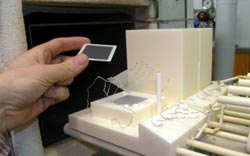Tests Prove Electrolytic Cells Are Stable at 850 Degrees

<br>
The results represent a step in the development of new energy storage systems. The use of electricity to generate hydrogen is considered to be a key technology for the storage of surplus energy from renewable sources. It could also play a crucial role in the transition of the energy system and the stabilization of grids.
As a result, Siemens' Industry Sector is developing and producing electrolyzers whose polymer electrolyte membrane (PEM) cells generate hydrogen at high pressure and temperatures under 100 degrees Celsius.
In a project funded by the German Ministry of Economics, scientists at Siemens' global research unit Corporate Technology (CT) have now also investigated high-temperature electrolysis. This technology could be more efficient than the conventional approach, since electrolysis reactions require a much lower cell voltage at high temperatures.
Another interesting property of high-temperature electrolysis is that the flow of the electricity can be reversed, allowing users to switch back and forth between efficient electrolysis processes and fuel cell operation. Such a system could use natural gas, biogas, or hydrogen to generate electricity or produce combined heat and power.
A future high-temperature electrolyzer could also be coupled with a system for synthesizing chemicals such as methane. The resulting waste heat could be used to generate the water vapor needed for high-temperature electrolysis. According to the researchers' simulations, hydrogen generation and methane synthesis would each have an efficiency of about 75 percent relative to their respective calorific values. This already takes into account the compression of the gases to 80 bars.
In the project, the CT researchers worked together with the ceramics manufacturer Kerafol and Forschungszentrum Jülich to optimize electrochemical cells that use an oxygen ion-conducting electrolyte as a substrate. The main challenge was to prevent the oxygen electrode from becoming detached, which had previously caused aging effects.
The researchers improved the electrode's stability by making it from a material that conducts electrons as well as oxygen ions. In a CT lab in Erlangen, ceramic electrolytic cells ran for more than 8,000 hours at 850 degrees Celsius. The cells had a current density of 0.5 amperes per square centimeter and a cell voltage of up to 1.1 volts. In this endurance test, the researchers noticed that the voltage-related aging amounted to only 0.2 percent per 1,000 hours of operation.
The researchers also demonstrated a concept for constructing the cell stacks. However, further development work is needed before larger cell stacks will have a sufficiently high level of long-term stability. The presentation of the lab results at project's sponsor brought the work on the three-year project's technology to a successful conclusion.
Media Contact
More Information:
http://www.siemens.com/innovationnewsAll latest news from the category: Power and Electrical Engineering
This topic covers issues related to energy generation, conversion, transportation and consumption and how the industry is addressing the challenge of energy efficiency in general.
innovations-report provides in-depth and informative reports and articles on subjects ranging from wind energy, fuel cell technology, solar energy, geothermal energy, petroleum, gas, nuclear engineering, alternative energy and energy efficiency to fusion, hydrogen and superconductor technologies.
Newest articles

Skyrmions move at record speeds
… a step towards the computing of the future. An international research team led by scientists from the CNRS1 has discovered that the magnetic nanobubbles2 known as skyrmions can be…

A flexible and efficient DC power converter for sustainable-energy microgrids
A new DC-DC power converter is superior to previous designs and paves the way for more efficient, reliable and sustainable energy storage and conversion solutions. The Kobe University development can…

Technical Trials for Easing the (Cosmological) Tension
A new study sorts through models attempting to solve one of the major challenges of contemporary cosmic science, the measurement of its expansion. Thanks to the dizzying growth of cosmic…





















